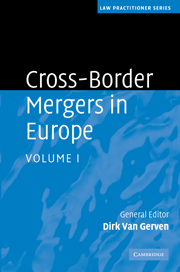Book contents
- Frontmatter
- Contents
- Contributors
- Preface
- Part I EC rules on cross-border mergers
- 1 Community rules applicable to cross-border mergers
- 2 Employee participation: rights and obligations
- 3 Tax rules applicable to cross-border mergers
- 4 Scope and limitations of the Cross-border Merger Directive
- Part II Application in each Member State National reports for the EU Member States
- Part III Application in the EEA Member States
- Part IV Annexes
- Index
2 - Employee participation: rights and obligations
from Part I - EC rules on cross-border mergers
Published online by Cambridge University Press: 03 May 2010
- Frontmatter
- Contents
- Contributors
- Preface
- Part I EC rules on cross-border mergers
- 1 Community rules applicable to cross-border mergers
- 2 Employee participation: rights and obligations
- 3 Tax rules applicable to cross-border mergers
- 4 Scope and limitations of the Cross-border Merger Directive
- Part II Application in each Member State National reports for the EU Member States
- Part III Application in the EEA Member States
- Part IV Annexes
- Index
Summary
Introduction
1. Further to the creation of the European company (SE) and the European cooperative society (SCE), the Community legislature, as part of its efforts to unify European corporate law and allow the existence of transnational corporate entities, adopted a directive on 26 October 2005 setting out the principles governing cross-border mergers within the European Union (the ‘Directive’).
As with the SE Directive and the SCE Directive, the Community legislature bore in mind the issue of employee involvement, which is regulated by Article 16 of the Directive. However, whilst both the SE and SCE Directives regulate the involvement of employees in general (i.e. information and consultation procedures, creation of a representative body and participation), Article 16 of the Directive only governs employee participation. All other aspects of employee involvement shall continue to be regulated by the relevant provisions of national law.
The Community legislature used the before-and-after principle as its starting point: insofar as possible, existing participation rights should be maintained within the company resulting from a cross-border merger.
This chapter examines the Directive's provisions on employee participation. Firstly, the geographic scope and entry into force of the Directive are clarified, followed by the substantive scope of Article 16 of the Directive. We then turn to the provisions determining participation rules in the framework of a cross-border merger and the procedure to determine participation rights.
- Type
- Chapter
- Information
- Cross-Border Mergers in Europe , pp. 29 - 43Publisher: Cambridge University PressPrint publication year: 2010
- 3
- Cited by

